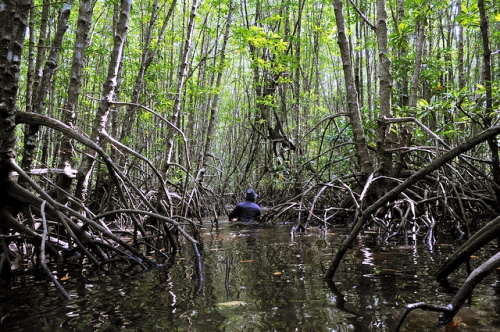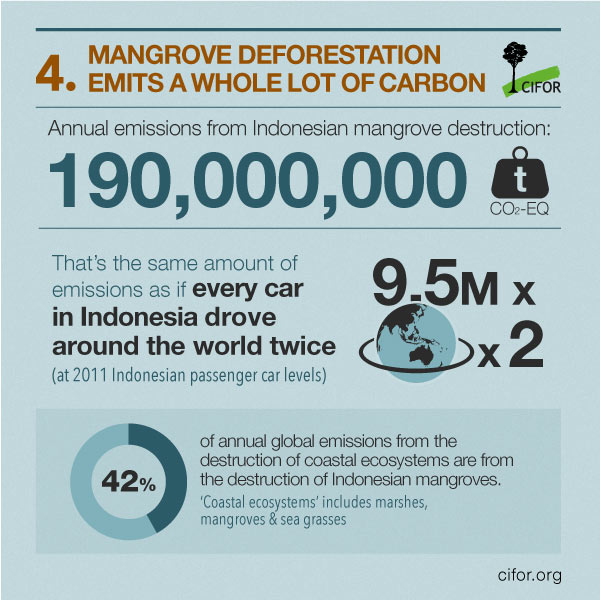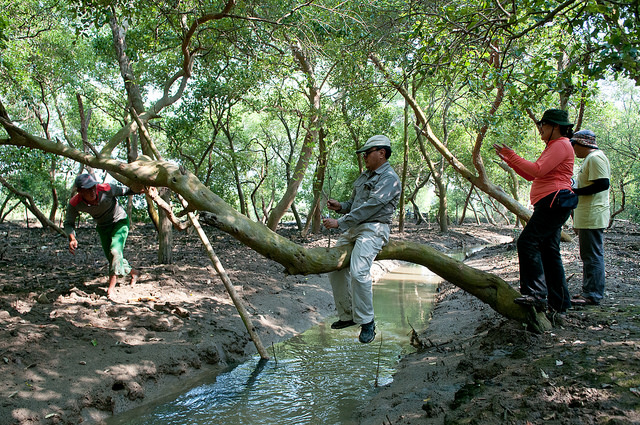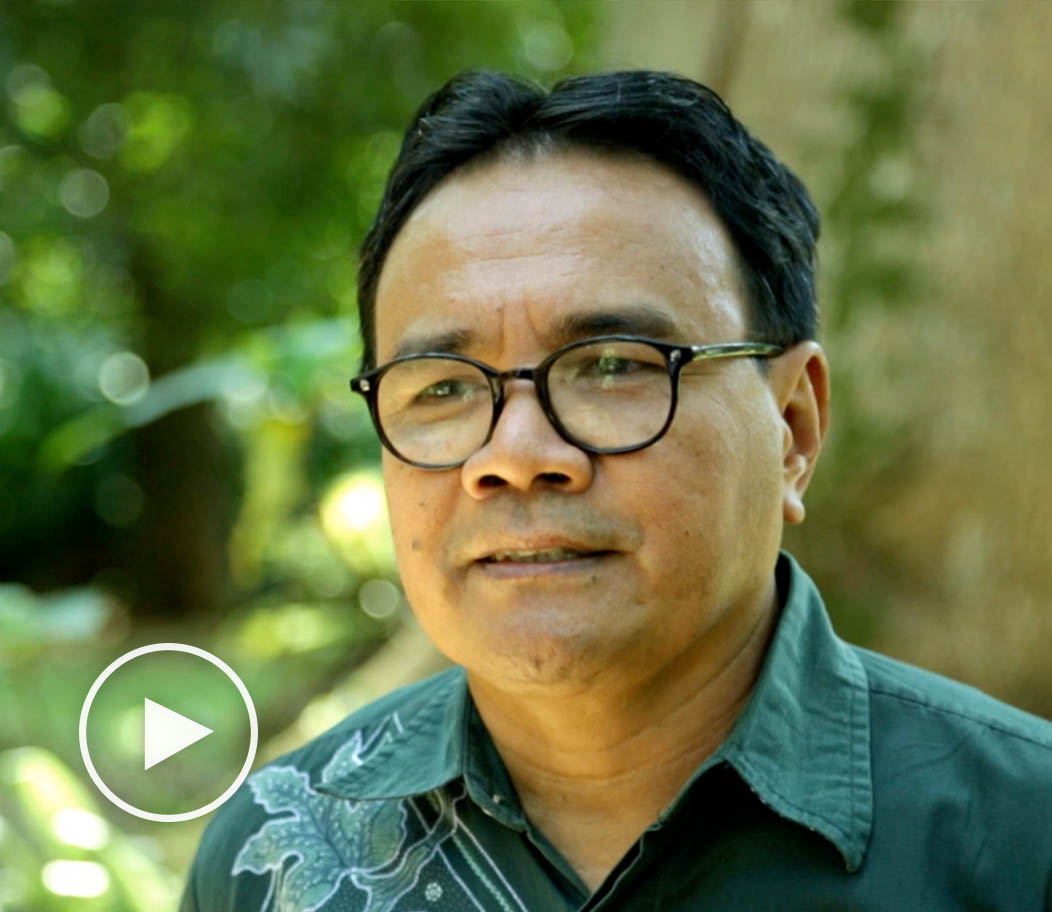
Indonesia contains the largest area of mangrove forest in the world
About 3 million hectares of mangrove forest grow along Indonesia’s 95,000 km coastline. This is 23 percent of all mangrove ecosystems in the world (Giri et al., 2011).
Mangrove forests are found in many parts of Indonesia, with regionally important mangrove ecosystems located in Papua, Kalimantan and Sumatra (FAO, 2007).
Mangrove trees in Indonesia can reach up to 50 metres in height. They are densely packed, with intertwined roots extending from the tree trunks. During the high tide, mangrove forests are flooded. During low tide, the ground is a layer of dense mud, with soil containing high levels of organic materials (FAO, 2007).
Indonesia’s mangroves are among the most carbon-rich forests in the world
Mangrove forests are the most carbon-dense forests in the tropics. They contain more than three times as much mean carbon per hectare as land based tropical forests (Donato et al., 2011).
Indonesia’s mangrove forests contain more than five times as much mean carbon per hectare as its upland tropical forests (Murdiyarso et al., 2015).
Mangroves contribute 10-15 percent of coastal sediment carbon storage despite making up only 0.5 percent of the global coastal area (Alongi, 2014).
Indonesia’s mangroves contain 3.14 billion metric tonnes of carbon (PgC) (Murdiyarso et al., 2015). This is one third of global coastal carbon stocks (Pendleton et al., 2012).
Mangrove ecosystems in Indonesia store large amounts of carbon below the ground: 78 percent of carbon in mangrove systems in Indonesia is stored in the soil, 20 percent of carbon is stored in living trees, roots or biomass, and 2 percent is stored in dead or downed wood (Murdiyarso et al., 2015).
Indonesia’s mangroves can play a significant role in national and global climate change mitigation strategies
Over the past three decades, Indonesia has lost 40 percent of its mangroves (FAO, 2007). This means Indonesia has the fastest rate of mangrove destruction in the world (Campbell & Brown, 2015).
Mangrove deforestation accounts for 6 percent of total annual forest loss in Indonesia, despite covering less than 2 percent of the country’s total forest area. This equates to 0.05 million hectares (Mha) out of the total 0.84 Mha annual deforestation in Indonesia (Margono et al., 2014; Ministry of Forestry Republic of Indonesia, 2014).
Mangrove deforestation in Indonesia results in a loss of 190 million metric tonnes of CO2 annually. This accounts for 20 percent of land-use emissions in Indonesia (Murdiyarso et al., 2015) where emissions are estimated to be 700 million metric tonnes of CO2-eq (Ministry of Environment Republic of Indonesia, 2010).
By avoiding mangrove deforestation, Indonesia could reach a quarter of its emissions reduction target of 26 percent by 2020 (Murdiyarso et al., 2015).
The loss of mangrove forests in Indonesia contributes to 42 percent of the global greenhouse gas emissions from the destruction of coastal ecosystems, including marshes, mangroves and sea grass (Murdiyarso et al., 2015; Pendleton et al., 2012).
Mangroves in Indonesia are threatened by the “blue revolution”
The main causes of mangrove loss in Indonesia include conversion to shrimp ponds known as the “blue revolution” (Sumatra, Sulawesi and East Java), logging and conversion of land to agriculture or salt pans (Java and Sulawesi) and degradation due to oil spills and pollution (East Kalimantan) (FAO, 2007).
In 2013, Indonesia’s revenue from shrimp export approached USD 1.5 billion; almost 40 percent of the total revenue from the Indonesian fishery sector (Ministry of Marine Affairs and Fishery, 2014)
Mangrove forests in Indonesia provide benefits to local communities and support livelihoods
Local communities harvest shrimp, eel, clam, crab, sea snail and a variety of fish species from mangrove ecosystems, providing both income and food for families (Armitage, 2002).
Local communities use mangrove forests for firewood and construction materials, including beams for building houses and furniture (Armitage, 2002).
Fishers use products from mangrove forests to make anchors for boats, joints for boat stabilizers, and dye for fishing nets (Armitage, 2002).
Mangrove wood is sold for the paper pulp business, as well as for charcoal production, wood chips and firewood. These products are harvested at both small and large scales, contributing to local livelihoods and national exports (Evans, 2013).
Intangible benefits of mangrove ecosystems include social and cultural functions. Mangrove forests support religious and spiritual values, as well as recreational and aesthetic values for ecotourism (UNEP, 2014).
Mangroves support a wide range of ecosystem services
Mangroves provide support to a wide range of neighboring ecosystems, including coral reefs, seagrass beds, mud flats and sand flats (UNEP, 2014).
Environmental functions of mangrove ecosystems include nutrient supply and regeneration, recycling of pollutants, water cycling and the maintenance of water quality (Ruitenbeek, 1994).
Mangroves provide a crucial defence against coastal erosion. The roots bind the soil together and change the water flows, preventing the removal of sediment from shorelines (UNEP, 2014).
Mangrove forests help reduce the impacts of storm surges, large waves, and high winds brought on by tropical cyclones. They do this by reducing the wave energy as it passes through the mangrove forest, acting as a barrier between the waves and the land (UNEP, 2014).
Mangroves provide habitats for marine and terrestrial species
Below the water, mangrove forests serve as breeding and nursing grounds for fish and marine species. The roots and the soft layer beneath the trees provide food, shelter and protection from predation (Nagelkerken et al., 2008).
Above the water, the mangrove trees and canopy serve as a habitat for birds, insects, mammals and reptiles. Mangroves are the main habitat for the endangered Proboscis Monkey, found in Indonesia and endemic to Borneo (Mangrove Action Project, 2015).
REFERENCES
Alongi, D. M. (2014). Carbon cycling and storage in mangrove forests. Annual review of marine science, 6, 195-219.
Armitage, D. (2002). Socio-institutional dynamics and the political ecology of mangrove forest conservation in Central Sulawesi, Indonesia. Global Environmental Change, 12(3), 203-217.
Campbell, A., & Brown, B. (2015). Indonesia’s vast mangroves are a treasure worth saving. The Conversation. from http://theconversation.com/indonesias-vast-mangroves-are-a-treasure-worth-saving-39367
Donato, D. C., Kauffman, J. B., Murdiyarso, D., Kurnianto, S., Stidham, M., & Kanninen, M. (2011). Mangroves among the most carbon-rich forests in the tropics. Nature Geoscience, 4(5), 293-297.
Evans, K. (2013). Could sustainable logging save Indonesia’s mangroves? Forest News: A blog by the Center for International Forestry Research. from http://forestsnews.cifor.org/14229/could-sustainable-logging-save-indonesias-mangroves#.VZIkIlxTDhI
FAO. (2007). The world’s mangroves 1980-2005. Rome: Food and Agriculture Organization of the United Nations.
Giri, C., Ochieng, E., Tieszen, L. L., Zhu, Z., Singh, A., Loveland, T., . . . Duke, N. (2011). Status and distribution of mangrove forests of the world using earth observation satellite data. Global Ecology and Biogeography, 20(1), 154-159.
Mangrove Action Project. (2015). Endangered Specied Associated with Mangroves. from http://mangroveactionproject.org/endangered-species/
Margono, B. A., Potapov, P. V., Turubanova, S., Stolle, F., & Hansen, M. C. (2014). Primary forest cover loss in Indonesia over 2000-2012. Nature Climate Change.
Ministry of Environment Republic of Indonesia. (2010). Indonesia second national communication under the United Nations Framework Convention on Climate Change. Jakarta.
Ministry of Forestry Republic of Indonesia. (2014). Recalculation of Indonesia’s land cover in 2013 (in Indonesian): Direktorat Jenderal Planalogi Kehutanan.
Ministry of Marine Affairs and Fishery. (2014). Export of Fishery Products. Retrieved 8 July, 2015, from http://statistik.kkp.go.id
Murdiyarso, D., Purbopuspito, J., Kauffman, J. B., Warren, M., Sasmito, S., Donato, D., . . . Kurnianto, S. (2015). The potential of Indonesian mangrove forests for global climate change mitigation. Nature Climate Change. Vol.5, DOI: 10.1038/NCLIMATE2734
Nagelkerken, I., Blaber, S., Bouillon, S., Green, P., Haywood, M., Kirton, L., . . . Sasekumar, A. (2008). The habitat function of mangroves for terrestrial and marine fauna: a review. Aquatic Botany, 89(2), 155-185.
Pendleton, L. Donato, D.C., Murray, B.C. et al. (2012) Estimating global “Blue Carbon” emissions from conversion and degradation of vegetated coastal ecosystems. PLoS ONE 7 (9):e43542.
Ruitenbeek, H. (1994). Modelling economy-ecology linkages in mangroves: Economic evidence for promoting conservation in Bintuni Bay, Indonesia. Ecological Economics, 10, 233-247.
UNEP. (2014). Importance of Mangroves to People: A Call to Action: United Nations Environment Programme World Conservation Monitoring Centre, Cambridge.
We want you to share Forests News content, which is licensed under Creative Commons Attribution-NonCommercial-ShareAlike 4.0 International (CC BY-NC-SA 4.0). This means you are free to redistribute our material for non-commercial purposes. All we ask is that you give Forests News appropriate credit and link to the original Forests News content, indicate if changes were made, and distribute your contributions under the same Creative Commons license. You must notify Forests News if you repost, reprint or reuse our materials by contacting forestsnews@cifor-icraf.org.


